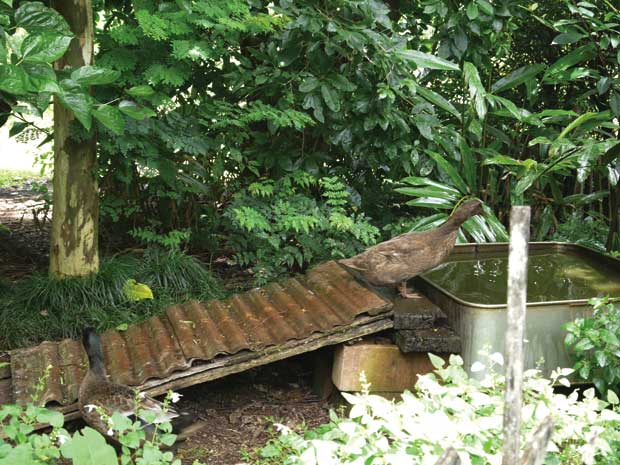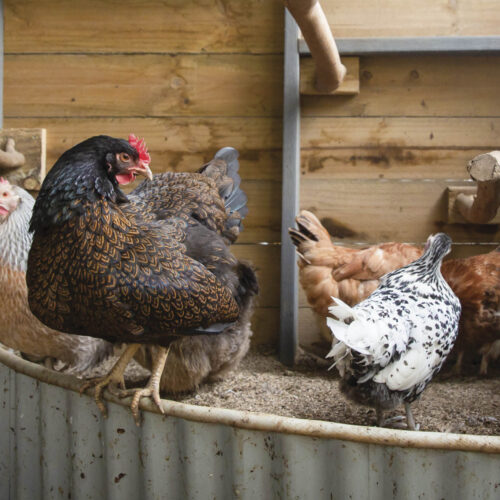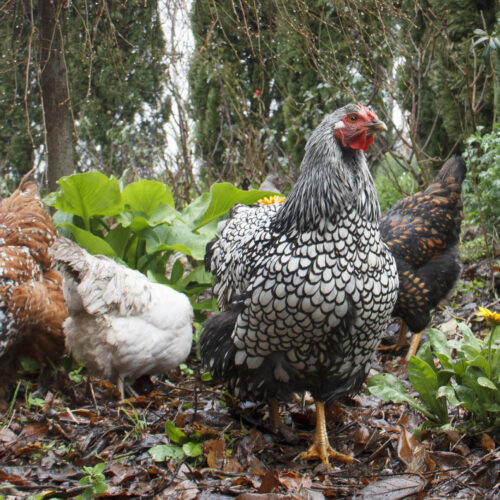Ducks fit the bill
2012-06-02T01:47:05+10:00
Are you looking for a natural slug, snail and grasshopper destroyer? Something that will also provide eggs and manure? The duck is your answer, writes PAUL HEALY.
For centuries the duck has been a universal symbol of domestic gentleness and docility, and it is no accident that philosopher and cartoonist Michael Leunig has made this creature one of the great Australian icons of escape from the stress and fret of modern urban living.
And for the organic gardener, ducks fed and cared for properly are delightful and useful: producing eggs, meat, feathers and manure which will be deposited at twice the rate of chickens. Plus they will remove pests, including grasshoppers, slugs, snails and mosquito larvae when foraging the garden.
Ducks are the best hunters and destroyers of slugs and snails, but unlike chickens, will not scratch over seed beds or scatter litter, and this makes them ideal for ranging beneath and between mulched rows of vines crops and fruit trees.
However, ducks will flatten young seedlings and emerging bulbs, while salad crops, silverbeet, brassicas and lettuce must be fenced off from a flock. Ducks are also excellent at cleaning up post harvest residue.
Duck droppings can very easily overload small areas of lawn or garden, so you may need to divide your space into at least two foraging areas – allowing one half to be resting at all times. In smaller gardens, keep no more than three birds, and limit their access to just one hour of grazing per day, in the evening when they will forage for insects more actively.
Care and management
Ducks are perfectly suited to small-scale, organic husbandry and can cope with more rudimentary housing and harsher weather in the open than chickens. However, to grow and lay to their best potential, they require eastward-facing nests protected from wind and rain. Their predator-proof night shelters are best kept uncluttered for easy cleaning.
Ducks are social animals and must have company. Three to five birds for the home garden is the ideal number. If you keep only a pair, if one dies, its surviving companion will fret. When keeping drakes, a ratio of no less than three ducks to one drake is recommended for lighter, more sexually active breeds, while for heavier breeds such as the Aylesbury or Rouen, mate no more than three ducks to a drake.
Overcrowding can cause stress, weight loss and reduced egg laying. The minimum amount of space required is one square metre per bird in a shelter at night, and three square metres in an enclosed run by day.
Even where they can swim, ducks may still harbour lice as well as internal parasites, and they need to be dusted, just the same as fowls, and fed a worming mash once each month.
Housing
Night shelters should be a secure shed or a run netted up the sides and over the top with 12mm wide, square, heavy gauge mesh. Failing that, use 30mm galvanised, heavy gauge rabbit netting secured to a concrete strip footing for the length of the shed or run (to stop predators digging). An alternative to a strip footing is a pegged wire ‘skirt’, laid flat and extending 400mm from the base.
Unlike chickens, most ducks don’t perch so they don’t need roosts; they tend to sleep at ground level. The exception is some breeds of native duck and Muscovies, which may perch in trees.
Fixed sheds should preferably be built higher than your full standing height so regular egg collection and weekly litter renewal does not require stooping. If built lower, make them no deeper than 1.5 metres. However, shelters must have some all-day sun protection. Fruit and fodder trees flanking the run or shelter will provide good shade.
Because ducks don’t perch, they can be housed in small, portable shelters made from smaller rain tanks cut into domes. These small lightweight houses can be lifted and moved aside easily for cleaning and litter renewal.
Do not house ducks on timber floors, which will rot quickly, and never keep ducks directly on cement, which can lead to problems with deformities and arthritis in their feet, legs and body.
Fencing
Ducks need to be protected from predators such as dogs, foxes, cats, pythons and quolls. Perimeter fencing should be 1.8 metres high, and if not solid metal sheet or palings, must be heavy-gauge rabbit wire netting.
In rural areas, I recommend at least three electric outriggers set at 30cm, 1m and 1.8m high. These should be set outside the fence, 15cm from the netting.
Unlike wild ducks, most domesticated duck breeds can’t fly (though Muscovies will fly, and far) so internal fencing need only be about 120cm high. However, for lighter more flighty breeds, wing clipping may be necessary (this is not painful to the duck).
Litter
For the litter, any straw, sawdust, leaves, hay, rice hulls or shredded bark – or a mix of these – will do. In damp areas, lay the litter on a bed of 100mm sharp potting sand set down on an earthen floor.
Duck pens soon become damp places. Their litter is quickly matted with droppings and should be changed weekly, or renewed by adding thin layers of new bedding every five to eight days (after first sprinkling the old layer with dolomite). About once a month, replace the whole litter.
Duck litter makes a great base for a new no-dig bed or compost heap, and is especially good recycled through worm farms built close to the pen.
Water
Ducks need to regularly clear their nostrils of mud and dirt. Make water vessels at least 30cm deep so they can plunge their heads and bills fully below the surface. They will squirt mud through their bills into water containers, quickly fouling the water and mucking the area around it, so change the water daily. Though ponds are required for the mating of heavier, more clumsy breeds, ducks generally do not need large bodies of water in which to swim. Small, easily cleaned, recycled baby baths or wader pools are perfectly adequate.
Ducks and soil
Ducks can improve the fertility of your soil at a rapid rate and have been used by farmers to enrich poorer soils and sandy pastures. However, overstocking on heavy clay loams can bog and ruin your garden in just one wet winter of neglect, as the sucking action of their feet will create a vacuum that will draw up subsurface moisture.
To alleviate this problem in their yards and runs, lay down a base of sharp, coarse, river or potting sand that will provide better drainage. The bonus is that when the yards are cleared this can be shovelled into the compost heap, eventually adding texture to your garden soil or growing medium. Do not use coarse gravel to improve drainage beneath runs as it will soon be choked by mud, and when mixed with litter that is used on the garden, will ruin the soil.
Food
Ducks are omnivores, like chickens, and eat a similar diet. You can feed ducks the same commercially available mixed grains and the same daily milk mash as you would chickens, but due to their higher metabolic rates, ducks will consume 50 to 80 per cent more feed per bird than chickens.
To give your ducks’ immune systems a boost, once a week add 25 grams of dried kelp powder per bird to the mash, and feed eight sunflower seeds per bird per day to provide oils that are essential to healthy waterproof plumage. A homemade mash can be made from:
- 7 parts wheat
- 2 parts barley
- 1 part oats or other grain
- wetted with whole milk (no water).
Feed this mash to the ducks in the morning, then give them whole grains in the evening at the following rates per bird per day:
- Smaller and miniature breeds, such as Elizabeth, Appleyard, Mallard: 150g mash, 50g grain.
- Small to medium breeds, such as Runner, Campbell, Orpington, Cayuga: 200g mash, 100g grain.
- Large breeds, such as Aylesbury, Rouen, Pekin: 250g mash, 150g grain.
Like chickens, ducks must have unrestricted access to containers of hard grit and shell grit. They thrive when given daily access to greens.
Longevity and fertility
In colder climates, the heavier, slower-growing breeds of duck may live for up to 15 years (Muscovies and geese can reach their 20s and 30s), but smaller, faster-growing breeds will average between five to eight years. Longevity will be reduced in hotter climates. Fertility and egg production will begin to decline after three to five years, but the rate of decline is affected by size, breed purity and the quality of the diet..
Although their gentle nature means ducks are the least likely of all poultry to cause harm to people, when poorly handled or harassed, their beating wings can badly bruise your face or arms, while the sharper bills of angry drakes can give you a nasty nip that is capable of breaking the skin.
When catching ducks, do not grab at the vulnerable, easily broken leg, but secure the neck, just below the head, with one hand. Wrap the other arm around the body before lifting. The body should be supported by both hands, with the duck’s head tucked under your arm.
While ducks will handle cold and wet weather conditions better than fowls, as recent events in Victoria have shown, they are just as prone to transmissable diseases such as avian influenza, and will suffer, more than fowls, from malformations of the bones and to illness caused by nutritional deficiencies in poorly managed diets.
Choosing a breed
Different duck breeds suit different purposes (see ‘Useful duck breeds’ chart on page 37). Some are bred to be purely ornamental, while others have been selected and developed for egg or meat production.
A pair of well-bred female Campbell or Indian Runner ducks will supply you with more than 300 eggs a year. Duck eggs have harder shells, more yolk to white than chicken eggs, and thicker whites. While egg colour and flavour will vary with the diet – as it will with fowls – duck eggs are richer to the taste and some people find them harder to digest. Many cooks say duck eggs are superior for baking.
If it is a large plate of rich dark meat that you are after, you cannot go past a Rouen, or a cross between the Rouen and the Pekin, or the Rouen and Aylesbury.
The Pekin, Indian Runner and Cayuga are better for hot and tropical climates, but will still do well in southern latitudes. The Campbell, Rouen and Aylesbury prefer cooler, more temperate climates.
Ducks fed on organic diets can take 10 to 18 weeks to fatten for the table: the heavier the breed, the slower its growth, but the finer, tastier, better quality dark meat comes with slower growth.
The best breeds for the garden and the smallholding are the dual-purpose egg and meat breeds, of which the Buff Orpington is probably the best, closely followed by the Khaki Campbell.
When sexing, the mature male of many duck breeds has a slightly larger, coarser head, with a short curl at the base of the tail, which the female lacks. The drake of many breeds will also have a bluish green bill, whereas the female bill will be a darker brown to black.
The drake will call with a softer, deeper throat sound, while the duck will quack with a louder, sharper, thinner tone and timbre.






